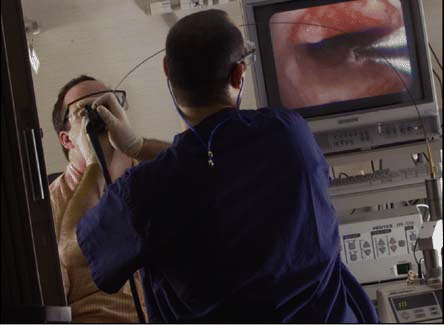Of all the lasers currently in use, however, the CO2 laser is the most commonly used and remains the standard of care. The CO2 laser is the ‘workhorse’ for the otolaryngologist because of its precise soft tissue interaction with minimal collateral damage, said Dr. Shapshay, adding that it provides for good hemostasis, photocoagulating capillary-sized blood vessels. Other lasers such as the YAG, KTP, and pulsed dye are useful for coagulation; however, they are not as precise as the CO2 laser, which has the best soft tissue interaction of any currently available lasers.
Explore This Issue
April 2007
Introduced to the field of otolaryngology in 1972 by Jako and Strong at Boston University, the CO2 laser was first used to ablate respiratory papillomatosis. Since then, the laser has also been used for a variety of head and neck procedures, including excising skin tumors, treating malignancies of the upper aerodigestive tract, treatment for polyps and papillomas in the larynx, capillary hemangiomas in the upper airway, removal of stapes footplate from the middle ear for treatment of otosclerosis, and even for tonsillitis and snoring.
The CO2 laser currently remains the laser of choice for most otolarynatologists, according to Dr. Shapshay.
Refinements to the CO2 Laser
Despite the success of this technology, as well as its availability for more than 30 years, the CO2 laser remains limited because it relies on a direct line of vision of the surgical site. According to F. Christopher Holsinger, MD, of the Department of Head and Neck Surgery at the University of Texas M. D. Anderson Cancer Center in Houston, this is a particular difficulty for head and neck surgeons who are trained in doing operations in open surgical fields. But use of the CO2 laser surgery in the hands of head and neck surgeons across institutions in the United States has expanded significantly over the last ten years-largely based on promising single-institutional studies in Europe, he said.
Improving the ability to deliver the CO2 laser in ways that allow the surgeon to maneuver the laser around a corner or to contour the resection with precise three-dimensional margins will expand the use of the laser in oncologic surgery, said Dr. Holsinger; this would be particularly effective for endoscopic transoral laser resections for laryngopharyngeal carcinomas. To have something that allows the head and neck surgeon to wield the laser as a scalpel is a natural transition from the open surgical approach, he said.
Leave a Reply